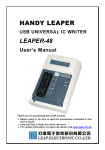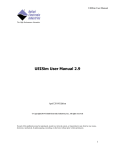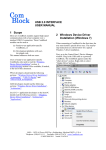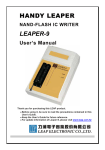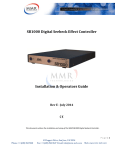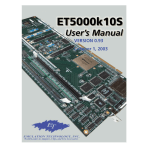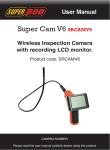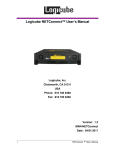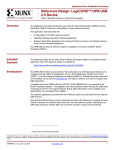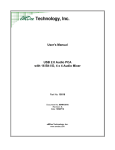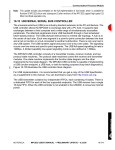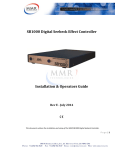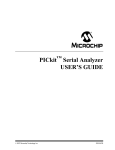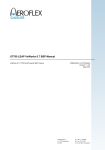Download User Manaul - Vreelin Engineering Inc.
Transcript
Vreelin Engineering Inc. USB2.0 High-Speed Device Interface for Altera SOPC Builder User Manual Core Facts Provided with Core Documentation User Manual Vreelin Eng. Inc. Design File Formats EDIF net list, Verilog Wrapper 747 Alice Ave. Mountain View, CA USA, 94041 Phone: (650) 386-5758 Fax: (650) 386-5758 E-mail:[email protected] Website: www.vreelin.com Extreme Performance 19 Megabytes/sec sustained throughput over USB (Cyclone II 100MHZ Avalon Bus) Verification only Instantiation Verilog templates Features • • • • • • • • • Test Bench with HDL Source license Logo Certified by www.usb.org Also supports Full Speed 12 pin ULPI I/F to external USB2 PHY 32 Bit Avalon Slave Interface 7 user endpoints plus control endpoint 0 Uses BRAM for endpoint FIFO’s Complete Firmware Windows XP Device Driver Working End to End Example Reference designs & Reference Design on Cyclone 2C35 application notes development board with SMSC 3300 USB2 PHY Daughter Card Firmware Complete Firmware stack provided Host Software Windows XP USB device driver and supporting user mode libs Core and Firmware is USB Logo Certified as a High-Speed USB device by the USB Implementer’s Forum Table 1: Example Implementation Statistics Family Example Device Fmax LE’s BRAM (MHz) Design Tools Stratix 2™ EP2S60 150 1500 1+ Quartus 6 Stratix 1™ EP1S40 150 1500 1+ Quartus 6 Cyclone II™ EP2C35 150 1500 1+ Quartus 6 © 2007, Vreelin Engineering, Inc. All Rights Reserved. Vreelin and other designated brands included herein are trademarks of Vreelin Engineering, Inc. * All other trademarks are the property of their respective owners. NOTICE OF DISCLAIMER: Vreelin Engineering, Inc. is providing this design, code, or information "as is." By providing the design, code, or information as one possible implementation of this feature, application, or standard, Vreelin makes no representation that this implementation is free from any claims of infringement. You are responsible for obtaining any rights you may require for your implementation. Vreelin expressly disclaims any warranty whatsoever with respect to the adequacy of the implementation, 5.0 including but not limited to any warranties or representations that this implementation is free from claims of infringement and any implied warranties of merchantability or fitness for a particular purpose. USB2.0 High-Speed Device Interface for Altera* SOPC Builder Table of Contents Features .......................................................................................................................................................... 1 Applications.................................................................................................................................................... 4 General Description ......................................................................................................................................... 4 Functional Description ..................................................................................................................................... 6 USB 2.0 Protocol ......................................................................................................................................... 6 USB 2.0 PHY .............................................................................................................................................. 6 USB 2.0 SIE ................................................................................................................................................ 6 Dual Port RAM............................................................................................................................................ 7 Avalon Bus Interface.................................................................................................................................... 7 Control & Status Registers............................................................................................................................ 7 SOPC Builder Verilog Wrapper .................................................................................................................... 8 Firmware Overview ......................................................................................................................................... 9 Chapter 9 Support ........................................................................................................................................ 9 User Endpoint Firmware............................................................................................................................... 9 The Standard Configuration .......................................................................................................................... 9 USB Gross Condition Handling .................................................................................................................... 9 Non Standard Firmware Configurations........................................................................................................... 11 Modify the Standard Configuration ............................................................................................................. 11 Create Completely New Descriptors ............................................................................................................ 11 Write New Firmware.................................................................................................................................. 12 Host Software................................................................................................................................................ 13 Firmware High Level API .............................................................................................................................. 14 void USBInit(usb_dev* dev, int base, int irq) ............................................................................................... 14 int USBWrite(end_point, NoBlock, ptr, len)................................................................................................. 14 int USBRead(end_point, NoBlock, ptr, len) ................................................................................................. 14 int USBIoctl(end_point, int request, pvoid) .................................................................................................. 15 Requests applicable to endpoint 0 only:.................................................................................................... 16 Windows* XP user level API ......................................................................................................................... 18 DWORD USBInit(void) ............................................................................................................................. 18 DWORD USBOpen(int end_point) ............................................................................................................. 18 DWORD USBClose(int end_point) ............................................................................................................. 18 DWORD USBRead(int end_point, char *ptr, int len) .................................................................................... 18 DWORD USBWrite(int end_point, char *ptr, int len) ................................................................................... 18 DWORD USBIoctl(int end_point, DWORD request, void *inbuffer, DWORD inbuffersize, .......................... 19 void *outbuffer, DWORD outbuffersize) ..................................................................................................... 19 IOCTL_RESET_PIPE ............................................................................................................................ 19 IOCTL_GET_CONFIG .......................................................................................................................... 19 IOCTL_RESET_DEVICE ...................................................................................................................... 19 Usbhaldemo1.c and Usbapp.c ......................................................................................................................... 19 Core Modifications ........................................................................................................................................ 20 Core I/O Signals ............................................................................................................................................ 20 Avalon Memory Map..................................................................................................................................... 21 Microprocessor Bus Memory Map (Port B of Dual Port RAM)...................................................................... 21 Endpoint Configuration Space..................................................................................................................... 21 Endpoint Config Status Register.................................................................................................................. 22 Hard Coded Registers .................................................................................................................................... 23 USB Address Register ................................................................................................................................ 23 Control Register......................................................................................................................................... 23 www.vreelin.com Vreelin Engineering, Inc. USB2.0 High-Speed Device Interface for Altera* Status Register ........................................................................................................................................... 24 USB Frame Number Register...................................................................................................................... 25 Interrupt Enable Register ............................................................................................................................ 26 Buffer Ready Register ................................................................................................................................ 27 Test Mode Register .................................................................................................................................... 27 Verification Methods ..................................................................................................................................... 28 The Hardware I/O Port Option........................................................................................................................ 29 HWIF Port Signals ..................................................................................................................................... 29 User Hardware Demo ................................................................................................................................. 29 Sequence to Sink Data from USB................................................................................................................ 30 Sequenece to Source Data to USB ............................................................................................................... 30 Use of HWIF_EP_Adrs .............................................................................................................................. 30 Use of HWIF_Stall and HWIF_Ready ......................................................................................................... 30 Clock Implications ..................................................................................................................................... 30 © 2007, Vreelin Engineering, Inc. All Rights Reserved. Vreelin and other designated brands included herein are trademarks of Vreelin Engineering, Inc. * All other trademarks are the property of their respective owners. 3 USB2.0 High-Speed Device Interface for Altera* SOPC Builder USB 2.0 USB 2 PHY ULPI USB SIE 32 bit P o r Dual Port BRAM t A P o r t B 32 bit Avalon Bus I/F (SLAVE) Avalon Bus Control & Status Registers (32 bit wide) Figure 1: USB 2.0 Core Block Diagram Applications The Vreelin Engineering USB2.0 High-Speed Device Interface for Altera SOPC Builder adds a HighSpeed USB 2.0 compliant device interface to the user’s SOPC Builder design. This interface is suitable for USB centric, high performance, designs as well as for legacy port replacement applications. General Description The Vreelin USB 2 High Speed Device core and associated software implements a complete end to end solution for connecting an Altera SOPC Builder design to a Windows XP host using high speed USB 2 transactions. Complete firmware for the Altera NIOS2 microprocessor is provided in standard C and a stable, high performance Windows XP device driver is provided for the host PC. A demo application running under Micro C/OS2 RTOS and an associated application running on Windows XP not only demonstrate the operation of the core, device driver, and firmware, but also provide an excellent starting point for a user’s design. Overall performance of the USB 2 High Speed Device core is limited only by the speed of the Avalon bus and Windows XP. The core will sustain maximum possible USB 2.0 High-Speed data rates. The core provides ping-pong memories for each endpoint. No real-time movement of data by the NIOS processor or user hardware is required to meet USB specifications. However, overall throughput of the system is limited by the ability of the NIOS processor to move data in and out of the ping-pong memory. To achieve maximum performance, the core needs ~15 million 32 bit transactions per second over Avalon. On a Cyclone II (2C35) NIOS development board running Avalon and NIOS at 100MHZ, sustained USB throughput of 19 megabytes/sec using 512 byte bulk transfers is achievable using the supplied Vreelin software and firmware. This includes a complete Windows XP device driver, Windows XP support library, Windows XP demo console application, NIOS HAL firmware layer, UCOS 2 RTOS, and demo firmware application. Using the same software with the core configured with the optional hardware I/O port, sustained USB throughput of 44 megabytes/sec is achievable with 512 byte bulk transfers – essentially the maximum possible USB performance for bulk transfers. The USB 2 High Speed Device core is implemented in approximately 1500 LE’s on most current Altera devices including Cyclone II and requires a minimum of one block RAM (BRAM). Older devices require a minimum of four block RAM’s. Adding more BRAM’s to the design provides more space for endpoint FIFO’s. The BRAM’s are configured as a dual port RAM with asynchronous clocked ports. Verilog source code is provided for the dual port RAM so that a designer can make appropriate design tradeoffs in the dual port RAM’s implementation. As supplied, the dual port RAM is implemented as 2K by 32 bit using four BRAM’s. A 32 bit, byte addressable slave interface is implemented over Avalon. www.vreelin.com Vreelin Engineering, Inc. USB2.0 High-Speed Device Interface for Altera* On the USB side, the core uses the latest ULPI USB 2 PHY interface which requires only 12 pins. The core implements completely asynchronous dual clock domains. The USB SIE side of the core runs off the ULPI PHY 60MHZ clock and the Avalon bus interface side runs off the Avalon clock. Note that for an understanding of USB 2.0 and all of its ramifications there are several sources. The USB 2.0 specifications available at www.usb.org is the standard definition, Mindshare and others have various books on the protocol, and Cypress Semiconductor has one of the best introductions in it’s “Easy USB FX User Manual” which can be downloaded at www.cypress.com. Read Chapter 1. Please note that in this document and others, I refer to Windows XP. Microsoft for good or bad, defines the host O/S operating requirements that USB devices must meet. Linux and other O/S’s are compatible. © 2007, Vreelin Engineering, Inc. All Rights Reserved. Vreelin and other designated brands included herein are trademarks of Vreelin Engineering, Inc. * All other trademarks are the property of their respective owners. 5 USB2.0 High-Speed Device Interface for Altera* SOPC Builder Functional Description A functional description of the High-Speed USB 2.0 Device Core for Altera NIOS follows. USB 2.0 Protocol A detailed description of the USB 2.0 protocol is beyond the scope of this data sheet. For that kind of description please refer to the USB 2.0 specification available from http://www.usb.org or to one of the many books that are available. For purposes of this data sheet, the USB 2.0 protocol multiplexes many devices over a single, half duplex, bit serial bus. The bus is designed to be plug and play. The bus runs at 480 mega bits per second. The PC always controls the bus and send tokens to each device specifying the required action. Each device has an address on the USB 2.0 bus and has one or more endpoints that are sources or sinks of data. All devices have endpoint 0, the system control endpoint. Unlike all other endpoints, endpoint 0 is full duplex and single buffered. The Vreelin device core has seven additional endpoints for the user’s application. When the PC wants to send data to a device’s endpoint, it sends an OUT token, along with the address of the device and the endpoint number followed by the data. To receive data, the PC sends an IN token with the device address and endpoint number and waits for data from the device. To perform system level control functions, including plug and play, SETUP tokens are sent by the PC to endpoint 0, along with setup information. The USB 2.0 core consists of 6 major hardware components and 4 software components. USB 2.0 PHY The PHY is user supplied. It can be any of the ULPI complaint PHY’s on the market. The PHY’s primary job is to handle the bit level serialization and de-serialization of USB 2.0 traffic. To do this it must also detect and recover the USB bus clock. This clock runs at 480MHZ and is too fast for practical implementation as programmable logic in the FPGA as well as in many ASIC’s. Since 480MHZ is also high for a core clock, the PHY interfaces to the USB 2.0 core on a byte serial basis and generates a 60MHZ clock. This clock runs the SIE side of the USB 2.0 core. It can also be used to run the entire FPGA if desired. Vreelin has had great success as well as achieved USB Logo Certification using the SMSC USB3300 ULPI PHY. USB 2.0 SIE The USB 2.0 SIE (SIE) handles the serialization and de-serialization of USB traffic at the packet level and the multiplexing and demultiplexing of USB data to and from the core’s endpoints. The SIE also handles USB 2.0 state transitions such as suspend, resume, and USB reset. The SIE implements the protocol specified in Chapter 8 of the USB 2.0 specification. The SIE interfaces to the PHY using an industry standard set of handshaking lines called the ULPI interface. ULPI requires only 12 pins and is ideal for FPGA designs. Data to the FPGA from the USB is received from the PHY, error checked, and loaded into the appropriate area of the dual port RAM. Data www.vreelin.com Vreelin Engineering, Inc. USB2.0 High-Speed Device Interface for Altera* from the FPGA to be sent over the USB is loaded from the block RAM, protocol wrapped and presented to the PHY a byte at a time when the protocol allows. The status of current USB transactions are signaled by the SIE to the status register. Certain conditions can be enabled through the interrupt enable register to generate an interrupt on the Avalon bus. Dual Port RAM The Dual Port RAM is the data storage area between the USB SIE and the Avalon bus interface. It is fully dual port. Port A is used by the SIE, port B is used by the Avalon bus interface. For performance reasons, both ports are 32 bits wide. Port A is clocked by the ULPI PHY clock at 60MHZ and port B is clocked by the Avalon bus clock at any speed desired. There is no required phase relationship between the clocks. Data from USB is stored in the appropriate locations in Dual Port RAM by the SIE through port A. The user’s firmware or hardware accesses this data through port B over the Avalon. Data to the USB is loaded by the user through the Avalon Bus to port B into the appropriate locations in the Dual Port RAM. When the PC requests data from the device, the SIE accesses this data from port A. The Dual Port RAM is “seen” by the SIE as eight endpoint FIFO’s, plus a control register area that defines how the memory is laid out. Each FIFO is implemented as ping pong buffers to help support the high throughput possible with USB 2.0. One buffer can be used for a current USB transaction while the other buffer is available to the user application for processing. The storage areas are treated as FIFO’s only from the SIE’s point of view. The user’s firmware or hardware can access the storage as ordinary RAM over Avalon. Dual Port RAM based registers are located in the lower 64 bytes of Dual Port RAM that control the layout of each endpoint’s FIFO’s in Dual Port RAM, the communications direction (OUT or IN) of the endpoint, the endpoint’s type (Bulk/Interrupt or ISO), and certain internal state information. To provide flexibility to the designer and to minimize the resources used by the USB 2.0 Core, the Verilog source code for the dual port RAM implementation is provided. The designer can then optimize for his particular needs. As supplied, 4 2kx8 BRAM’s are used. More or less can be used as long as port A is 32 bit addressable and port B is 8, 16, and 32 bit addressable. Avalon Bus Interface The Avalon bus interface connects port B of the dual port RAM and the Control & Status Registers to the Avalon bus. This is a slave interface that looks like RAM. Byte, half word and word transfers are supported. Control & Status Registers The Control and Status Registers control operation of the USB 2.0 core, report the core’s status, sets the USB function address, indicates buffer ready condition to the USB SIE, and enable interrupts. These registers are implemented as registers in hardware, not block RAM. They are accessed over Avalon in the upper 16K byte address space of the core. They are the address register, control register, status register, current USB frame number register, interrupt enable register, buffer ready register and the mode control register. © 2007, Vreelin Engineering, Inc. All Rights Reserved. Vreelin and other designated brands included herein are trademarks of Vreelin Engineering, Inc. * All other trademarks are the property of their respective owners. 7 USB2.0 High-Speed Device Interface for Altera* SOPC Builder The address register contains the function address of the USB 2.0 core. It is written by firmware and must be set in accordance to Chapter 9 commands from the host. The control register currently only implements a master enable bit. Until this bit is set, the SIE is held in reset and will not respond to USB traffic. The status register reports on current USB conditions such as USB Reset, USB Suspend, USB Resume, USB Disconnect, setup packet received, and buffer complete status for each endpoint and each buffer. The frame number register reports the most current USB SOF packet received. Both major 1MS frames and minor 128 microsecond frames are reported. The interrupt enable register determines which status register events and which endpoints cause an interrupt to the Avalon. Reading the status register clears any current interrupt. The buffer ready register indicates the ready status of each endpoint’s two FIFO buffers to the SIE. Only buffers that are indicated as ready will by loaded or unloaded by the SIE in response to USB transactions. SOPC Builder Verilog Wrapper The Verilog wrapper is used by SOPC Builder to set the address range for the USB 2.0 core in the Avalon address map. The wrapper instantiates the core and does the master address decode for Avalon bus transactions. www.vreelin.com Vreelin Engineering, Inc. USB2.0 High-Speed Device Interface for Altera* Firmware Overview The firmware has 3 main areas of operation. First, the firmware implements all of the requirements of the USB 2.0 specification chapter 9, otherwise known as the “chapter 9 firmware” that operates against endpoint 0. Second, the firmware provides both low level primitives and high level abstraction interfaces to the user endpoints (1 to 7). Unix style stream I/O interfaces such as USBRead, USBWrite, and USBIoctl are provided for each of the user endpoints. Third, the firmware handles gross USB conditions such as USB Reset, Suspend, Resume, and Disconnect. Chapter 9 Support Chapter 9 of the USB specification concerns itself with the enumeration process with the USB host the device is plugged into. This process is complex and takes a newly plugged in USB 2.0 high speed device to the configured or enumerated state. In this state, the USB Host knows what the device implements and how to talk to it. During normal operation, there are other endpoint 0 communications that can take place that the Chapter 9 firmware will handle. For the most part, this is transparent to the designer. All that is required is for the microprocessor system to ether provide an interrupt handling routine that services the device core’s status register interrupt and dispatches to the appropriate firmware or polls the status register on a frequent enough interval and dispatches to the appropriate firmware. User Endpoint Firmware Endpoints 1 to 7 make up the user endpoints of the device core. Each endpoint may be programmed to be ether an IN or OUT endpoint (IN to the USB Host, OUT from the USB Host); may have packet sizes of from 2 to 512 bytes each for non-ISO endpoints and from 2 to 1024 bytes each for ISO endpoints. There is no requirement to use all of the user endpoints. The Standard Configuration In it’s simplest use case, the firmware defaults to the standard configuration. The standard configuration is designed to make it easier for a designer to add a USB interface to a design. Endpoints 1 to 3 are setup “out of the box” as OUT endpoints (from the HOST) as non-ISO and 512 byte packet size. Likewise, endpoints 4 to 6 are setup as IN (to the HOST) as non-ISO and 512 byte packet size. Endpoint 7 is setup as an INTERRUPT IN (to the host) endpoint with a packet size of 16 bytes and is intended to be used for device status to the host. Using the USBRead, USBWrite, and USBIoctl function calls, Unix like stream I/O is provided to the designer over the user endpoints back to the host. In addition, the standard configuration includes a tested Windows XP device driver that supports the above endpoint configuration and a user level support library and demo application. With the Host set of software plus the provided firmware, the designer can add 6 high speed USB 2.0 endpoints to his design, plus a status endpoint and access all of them from application space under Windows XP out of the box. USB Gross Condition Handling Since USB is “Plug and Play” code is provided to handle the Plug and Play aspects of USB. USB Disconnect happens when the user unplugs the USB cable. The firmware will properly shut down I/O and © 2007, Vreelin Engineering, Inc. All Rights Reserved. Vreelin and other designated brands included herein are trademarks of Vreelin Engineering, Inc. * All other trademarks are the property of their respective owners. 9 USB2.0 High-Speed Device Interface for Altera* SOPC Builder return the core to the USB unenumerated state waiting for a new plug in. USB Reset happens on host command. Similar firmware comes into play as for USB Disconnect. USB Suspend / Resume handles the go to sleep and wakeup aspects of USB and safely suspends and resume I/O operation. In addition using the USBIoctl high level abstraction interface, user provided call backs can be installed the will be “called out” on any of the above conditions to handle user specific situations. Please note that all of these callbacks are called at interrupt service time (if interrupts are being used) and should be short and to the point. www.vreelin.com Vreelin Engineering, Inc. USB2.0 High-Speed Device Interface for Altera* Non Standard Firmware Configurations If the standard configuration will not provide the needed functionality for a designer, then the firmware provides several options to produce non standard configurations. Modify the Standard Configuration This method will work best when the desired configuration is not too different from the standard configuration. Perhaps the number or direction of endpoints are different or the packet sizes need to be tweaked. This approach works as follows: 1. The designer must modify the descriptors provided for the standard configuration in usb.c using the structure definitions in usb.h. These descriptors must match the desired USB configuration. 2. Call USBInit as usual. This loads the modified descriptors into the firmware. 3. Then appropriate calls must be made to USBIoctl to set each endpoint’s characteristics to match what was set in the modified descriptors. These calls can include setting the base address in dual port RAM for each endpoint’s buffers and the size of those buffers. Warning: The designer must be careful in the assignment of endpoint base addresses and sizes since there is no contention checking between endpoints in the dual port RAM. The core will happily DMA anywhere into dual port RAM it is told to for an endpoint including right over other endpoint’s buffer areas. 4. Use the other USBIoctl calls to set call backs for USB Reset, Suspend, and Disconnect. 5. Continue with normal startup and operation The calls USBRead, USBWrite, and other USBIoctl calls are still available once the endpoints have been customized as long as the right call is made to the right endpoint – I.E. – USBRead to an OUT endpoint, USBWrite to an IN endpoint for example. Create Completely New Descriptors If the designer needs a USB configuration that is completely different from the standard configuration supplied, then completely different USB descriptors will be needed. This approach will require a considerably higher understanding of USB at several levels. However, using the files usb.c and usb.h it is feasible to build something unique without writing firmware from scratch. Some things to consider: Look at the layout of the descriptors at the top of usb.c and their corresponding structure definitions in usb.h. Look at the function USBInit in usb.c. Follow it’s logic flow and notice how the descriptors are copied into data structures. These descriptors are presented to the USB host on demand through the chapter 9 code in the firmware. The chapter 9 function, GetDescriptor parses chapter 9 requests and selects the appropriate descriptor for transmission over USB. Both USBInit and GetDescriptor may have to be modified. © 2007, Vreelin Engineering, Inc. All Rights Reserved. Vreelin and other designated brands included herein are trademarks of Vreelin Engineering, Inc. * All other trademarks are the property of their respective owners. 11 USB2.0 High-Speed Device Interface for Altera* SOPC Builder The function Init_Usb_Interfaces will have to be modified to match the endpoint configurations in the new descriptors. The standard configuration API calls USBRead, USBWrite, and USBIoctl can still be used if desired. Write New Firmware The files usb.c and usb.h contain a great deal of code that can be reused, if new firmware is desired. Most of the low level functions are quite useful in a customer firmware situation. Complete hardware interface definitions are provided later in this document. In any of the above cases, Vreelin Engineering is available on consulting basis to help with customization. Any modifications on the device (core) side, must match with the device driver and INF file on the PC side. Modifying the Windows XP device driver is a non-trivial exercise. Vreelin is available to help with this on a consulting basis. If even more customization is required, see the firmware source code. Lower level software primitives are provided to manipulate all endpoints as well as move date in and out of the dual port RAM. Vreelin is available on a consulting basis to customize any of this for special designer needs. www.vreelin.com Vreelin Engineering, Inc. USB2.0 High-Speed Device Interface for Altera* Host Software The vast majority of hosts will be Windows PC’s. A completely functional Windows XP device driver that supports the standard configuration is supplied in source and object form with this release. This device driver brings all 7 user endpoints out to ring 3 application space. A support library and demo application is provided to show how to use the device driver. The device driver will handle the following changes in the USB core’s firmware without modification: • • • • • endpoint direction: IN or OUT endpoint maximum packet size endpoint type: Interrupt or BULK number of active endpoints (up to the max of 7) Note that the Windows XP device driver does not currently support ISO transactions. If ISO endpoint transactions are required or if integration with other Windows XP system components are required, then a custom device driver will be needed. Vreelin Eng. Inc. is available on a consulting basis to develop such device drivers. © 2007, Vreelin Engineering, Inc. All Rights Reserved. Vreelin and other designated brands included herein are trademarks of Vreelin Engineering, Inc. * All other trademarks are the property of their respective owners. 13 USB2.0 High-Speed Device Interface for Altera* SOPC Builder Firmware High Level API All of the standard configuration firmware and it’s API calls are contain in usbdevice.c. All of the data definitions and structures are contained in usbdevice.h. These files are located in the usbdevice\hal\src and usbdevice\hal\inc directories. In addition, a simple demo firmware application, usbdemo1.c is also located in usbdevice\drivers_and_examples directory. void USBInit(usb_dev* dev, int base, int irq) • usb_dev* dev • int base • int irq pointer to USB dev structure (a global in user code) base address of USB core’s on microprocessor bus interrupt assigned to the core USBInit will perform all one time core initialization including registering the core’s interrupt handler with the supported RTOS or HAL. The usb_dev structure should be allocated in the user’s global area and must be valid during interrupt processing time. int USBWrite(end_point, NoBlock, ptr, len) • • • • • int end_point int NoBlock char * ptr int len returns endpoint number 1 to 7 1 implies do not block on space available pointer to the buffer to write from maximum number of bytes to write number of bytes written This routine will write up to len bytes from the memory addressed by ptr and send it to the USB endpoint buffer as space is available. If NoBlock = 0, then USBWrite will suspend the caller until all of the requested data has been written. If NoBlock = 1, then only the available data will be written including 0 bytes if no buffer space is available. USBWrite will return the number of bytes written in all cases. int USBRead(end_point, NoBlock, ptr, len) • • • • • int end_point int NoBlock char * ptr int len returns endpoint number 1 to 7 1 implies do not block on data available pointer to the buffer to read into maximum number of bytes to read number of bytes read This routine will read up to len bytes from end_point. If NoBlock is set to 1, then only the number of bytes available up to len will be read. Otherwise, USBRead will block (ether suspend the task or spin loop depending on the environment) until the requested number of bytes in len are available. US www.vreelin.com Vreelin Engineering, Inc. USB2.0 High-Speed Device Interface for Altera* int USBIoctl(end_point, int request, pvoid) • int end_point • int request • void *pvoid endpoint number 0 to 7 IOCTL request number, defined in usb.h generic pointer to specific parameters Just as in most O/S’s, USBIoctl is the catch all call. The request determines the functionality of the call. Request applicable to the user endpoints ( 1 to 7): 1. I_SET_OUT_IN Pvoid points to an unsigned int that is 0 for OUT and 1 for IN. Note that and endpoint set to OUT receives data from the HOST and one set to IN sends data to the host. 2. I_SET_VALID Pvoid points to an unsigned int that is 1 for VALID and 0 for non VALID. And endpoint must be set to VALID to operate. If set to non VALID, the endpoint will ignore all I/O from the host. VALID is a maser enable bit for the endpoint. 3. I_SET_STALL PVOID points to an unsigned int that is 1 for STALL and 0 for non STALL. If STALL is set, then all I/O attempts from the host for this endpoint will received a STALL response. STALL is used in USB to indicate a need for host interaction. It is not used often. For normal operation, set the endpoint to non STALL. 4. I_SET_ISO PVOID points to an unsigned int that is 1 for ISO and 0 for non ISO. Isochronous endpoints have special characteristics. The endpoint may have a max packet size of up to 1024 as opposed to 512 for BULK. Packets are not handshaked and are not retried. 5. I_SET_BASE PVOID points to an unsigned int that contains the offset in 32 bit words from the beginning of dual port RAM to the start of the first packet buffer of two for the endpoint. It is the designer’s responsibility to layout the dual port RAM and to make I_SET_BASE and I_SET_SIZE calls that do not result in buffer overlap or writing of packet data to undesired locations. 6. I_SET_SIZE © 2007, Vreelin Engineering, Inc. All Rights Reserved. Vreelin and other designated brands included herein are trademarks of Vreelin Engineering, Inc. * All other trademarks are the property of their respective owners. 15 USB2.0 High-Speed Device Interface for Altera* SOPC Builder PVOID points to an unsigned int that contains the size of the endpoints packet buffers in bytes. Non ISO user endpoints can be up to 512 bytes in size. ISO endpoints can be up to 1024 bytes in size. Two packet buffers will be allocated in dual port RAM one after the other, so that if a designer uses this call with a value of 512 for example, 1024 bytes will be reserved. NOTE: Functions 1 to 6 require that an appropriate set of USB descriptors be supplied to the firmware using USBIoctl calls to endpoint 0 as described in this document below. Requests applicable to endpoint 0 only: I_STARTUSB This call starts the core. The core may be stopped and started at any time. However, stopping the core during USB enumeration or other host driven event times will cause unpredictable results. This call is primarily intended to allow the designer to setup the core characteristics with the core stopped and then to release the core for operation. I_STOPUSB This call stops the core. Not intended for normal use. I_SETUSBRESETCB Sets a user callback to be called when a USB Reset happens. PVOID points to a structure defined in usb.h that has a function pointer and a user data pointer that will be passed to the callback when called. The call back provided will be called at interrupt time, so it should be short and to the point. I_SETUSBDISCONCB Sets a user callback to be called when the USB cable is unplugged. PVOID points to a structure defined in usb.h that has a function pointer and a user data pointer that will be passed to the callback when called. The call back provided will be called at interrupt time, so it should be short and to the point. I_SETUSBSUSPENDCB Sets a user callback to be called when the USB goes into suspend. PVOID points to a structure defined in usb.h that has a function pointer and a user data pointer that will be passed to the callback when called. The call back provided will be called at interrupt time, so it should be short and to the point. I_SETUSBCONFIGCB Sets a user callback to be called when the firmware has received and accepted a configuration request from the host. PVOID points to a structure defined in usb.h that has a function pointer and a user data pointer that will be passed to the callback when called. The current configuration number will be passed as well. The call back provided will be called at interrupt time, so it should be short and to the point. www.vreelin.com Vreelin Engineering, Inc. USB2.0 High-Speed Device Interface for Altera* I_SETUSBSOFCB Sets a user callback to be called when a USB Start of Frame token is received. Note this is the 1 millisecond master start of frame, not the 125 microsecond sub frame. PVOID points to a structure defined in usb.h that has a function pointer and a user data pointer that will be passed to the callback when called. The current frame number will be passed as well. The call back provided will be called at interrupt time, so it should be short and to the point. See usb.c and usb.h for the rest of the IOCTL calls. © 2007, Vreelin Engineering, Inc. All Rights Reserved. Vreelin and other designated brands included herein are trademarks of Vreelin Engineering, Inc. * All other trademarks are the property of their respective owners. 17 USB2.0 High-Speed Device Interface for Altera* SOPC Builder Windows* XP user level API All of the files composing the Windows XP device driver, support library and demo application are contained in device_drivers\vreelindd. The device driver files are in the sub directory driver, and the demo application files and support library are in the subdirectory usbapp. The support library is usb.cpp and usb.h, the demo application is usbapp.cpp. The demo application is a Windows XP console application. DWORD USBInit(void) Finds the USB device in Windows XP device name space and performs magical incantations to get the device ready for individual calls to USBOpen for the endpoints. If the magic works, returns ERROR_SUCCESS, otherwise, the call returns the error encountered. DWORD USBOpen(int end_point) Open a handle to the specified endpoint, end_point. This function calls CreateFile, passing in a name space path to the individual endpoint. Returns ERROR_SUCCESS on successful open, otherwise the Windows XP system error code is returned. DWORD USBClose(int end_point) Close the handle to the specified endpoint, end_point. DWORD USBRead(int end_point, char *ptr, int len) • Int end_point endpoint to read from • Char *ptr buffer pointer to read into • Int len maximum number of bytes to read Will read the number of bytes requested from the specified endpoint into the buffer pointed to by ptr. The default settings will suspend the calling thread until the number of requested bytes are read. Returns on completion or error such as the USB device being unplugged. USBRead will return the number of bytes read or the error code if an error occurs. DWORD USBWrite(int end_point, char *ptr, int len) • int end_point endpoint to write to • char *ptr buffer to write from • int len maximum number of bytes to write Write the specified number of bytes to the endpoint from the buffer pointed to by ptr. Will suspend the caller until len bytes are written. Returns the number of bytes written or the system error code if an error occurs. www.vreelin.com Vreelin Engineering, Inc. USB2.0 High-Speed Device Interface for Altera* DWORD USBIoctl(int end_point, DWORD request, void *inbuffer, DWORD inbuffersize, void *outbuffer, DWORD outbuffersize) • int end_point endpoint to control • DWORD request DeviceIoControl code • void *inbuffer input buffer • DWORD inbuffersize input buffer size • void *outbuffer output buffer size • DWORD outbuffersize output buffer size Passed request through to the specified endpoint using DeviceIoControl. See the documentation for DeviceIoControl. Some requests are generic to all file I/O under Windows and would apply here. Others are device driver specific. The Windows XP device driver supplied with the core supports the following DeviceIoControl calls: IOCTL_RESET_PIPE This call will cause all I/O operations and the data toggle bit to be reset. Not normally needed IOCTL_GET_CONFIG Will return in the outbuffer the complete configuration descriptor unless the descriptor is larger than outbuffersize, in which case it will return outbuffersize bytes of the descriptor. IOCTL_RESET_DEVICE Reset the entire device including all endpoints. Not normally used. Usbhaldemo1.c and Usbapp.c Usbhaldemo1.c implements a demo firmware application that uses the firmware high level API as implemented in usb.c and usb.h. Usbapp.cpp similarly uses the ring 3 user API to talk to the Windows XP device driver. The two programs “play” together and are meant as a starting point for a designer’s application. © 2007, Vreelin Engineering, Inc. All Rights Reserved. Vreelin and other designated brands included herein are trademarks of Vreelin Engineering, Inc. * All other trademarks are the property of their respective owners. 19 USB2.0 High-Speed Device Interface for Altera* SOPC Builder Core Modifications The only modification that can be done with a net list license is the implementation of the dual port RAM. The Verilog source code is provided in the file dual_port_ram.v. Core I/O Signals The USB 2.0 core is an Avalon slave complaint interface intended to be used with the Altera NIOS. Table 1: Core I/O Signals Signal Signal Description Direction ULPI Interface clock Input 60MHZ ULPI clock for SIE generated by USB PHY ULPI_Dir Input When High, the PHY is outputting to ULPI_Data, the core see this on ULPI_Data_I ULPI_Next Input Data in or out on ULPI_Data is required to be valid on the next rising edge of clock ULPI_Stop Output When the core is transmitting on ULPI_Data, ULPI_Stop going high will signal the end of transmission. ULPI_Data[7:0] Bi-Dir ULPI bi-directional data bus – direction controlled by ULPI_Dir ULPI_Reset Output When high causes the external ULPI PHY to reset. Used to recover from PHY error conditions AVALON Bus Interface clk Input AVALON Bus clock reset Input AVALON Bus Reset – resets entire core address[31:0] Input AVALON Address bus bits 31 to 15 used for decode of core’s address space byteenable[3:0] Input AVALON byte lane selects, each bit corresponds to one of the 4 byte lanes on the AVALON data bus, supported by the core in the block RAM address space, not in the hard register space writedata[31:0] Input AVALON Data bus into the core read Input R/W select line, 0 = write, 1 = read Chipselect Input AVALON bus select line, 1 = valid cycle for this core, 0 = invalid readdata[31:0] Output AVALON Data bus out of the core Irq Output Interrupt line to the AVALON bus active high www.vreelin.com Vreelin Engineering, Inc. USB2.0 High-Speed Device Interface for Altera* Avalon Memory Map The following is the memory layout of the USB 2.0 Core as seen from the Avalon bus. The base address of the core is set by the NIOS2 utility SOPC Builder when the core is instantiated into the NIOS2 project Microprocessor Bus Memory Map (Port B of Dual Port RAM) Offset Description 0 to 0x80 Endpoint configuration space 0x80 to 0x87 Setup packet storage location (8 bytes) 0x88 to 0x3fff RAM for endpoint buffers Allocation is controlled by settings in endpoint configuration space. 0x4000 to 0x7fff Hard coded register space. 0x4000 USB Address 0x4004 Control 0x4008 Status 0x400C Current USB frame number 0x4010 Interrupt Enable 0x4014 Buffer Ready 0x4018 Mode Control (for USB certification) Note all offsets are byte offsets. Endpoint Configuration Space Each endpoint has 4 32 bit locations located sequentially and arranged by endpoint number. I.E.: Offset Description 0x00 Endpoint 0 0x10 Endpoint 1 0x20 Endpoint 2 0x30 Endpoint 3 0x40 Endpoint 4 0x50 Endpoint 5 0x60 Endpoint 6 0x70 Endpoint 7 For each endpoint there are four 32 bit words defining the endpoints behavior: Offset Description 0x00 Endpoint Config Status Register 0x04 Unused, but reserved 0x08 Buffer 0 count: 0 to 1024 0x0c Buffer 1 count: 0 to 1024 © 2007, Vreelin Engineering, Inc. All Rights Reserved. Vreelin and other designated brands included herein are trademarks of Vreelin Engineering, Inc. * All other trademarks are the property of their respective owners. 21 USB2.0 High-Speed Device Interface for Altera* SOPC Builder Endpoint Config Status Register BIT Name SET CLEAR Comments 31 EP_VALID_BIT Endpoint operations No endpoint Master enable / disable bit for the are allowed operations are endpoint allowed 30 EP_STALL_BIT Endpoint is stalled Endpoint is not When set, a STALL is the only stalled response to the host for this endpoint 29 EP_OUT_IN_BIT Endpoint responds to Endpoint responds IN transactions to OUT ISO endpoint Non ISO endpoint In/Out is with respect to the host. transactions 28 EP_ISO_BIT ISO endpoints do not send or expect ACK's or NAK’s 27 26 EP_DATA_TOGGLE_BIT EP_BUFFER_SELECT_BIT Data toggle is 1 and Data toggle is 0 and Used as weak form of will expect or send a will expect or send synchronization. DATA 1 packet a DATA 0 packet Current buffer is the Current buffer is second buffer the first buffer This field allows up Implements ping pong buffers 25 EP_PACKET_SIZE_MS MSB of the packet size 15 EP_PACKET_SIZE_LS LSB of the packet size 17 EP_PACKET_SIZE_QWA Used to index RAM in 32 bit 12 EP_BASE_MS MSB of the base offset in RAM of to 1024 byte packets chunks the buffers 0 EP_BASE_LS LSB of the base offset in RAM of the buffers www.vreelin.com Vreelin Engineering, Inc. USB2.0 High-Speed Device Interface for Altera* Hard Coded Registers USB Address Register Contains the Host assigned USB address of the device. Takes on values from 0 to 127. An address of 0 implies that the device is unenumerated and is the default address of all USB devices at plug in time. Reset by hardware to 0. Program by the microprocessor under supplied Chapter 9 firmware control. Control Register Only one bit, bit 31. When clear, the USB SIE is paused and will not respond to any USB activity. When set, the SIE operates normally. © 2007, Vreelin Engineering, Inc. All Rights Reserved. Vreelin and other designated brands included herein are trademarks of Vreelin Engineering, Inc. * All other trademarks are the property of their respective owners. 23 USB2.0 High-Speed Device Interface for Altera* SOPC Builder Status Register The status register reports status on the operation of the USB device core. It is an auto clear register. That is, when the microprocessor reads the status register, all bits reported are cleared. Bit Name Set Clear 23 USB Reset USB Reset active Normal comments Will remain set for up to 3 ms 22 USB Suspend USB Suspend active Normal Will remain set for as long as suspend which can be hours 21 USB Disconnect USB Cable unplugged USB Connect USB detach detection 20 FIFO Buf Rdy EP 0 Pkt Received 19 FIFO Buf Free EP 0 Pkt Transmitted 18 Setup Packet EP 0 Setup Pkt Rcv’ed 17 SOF Packet Start of Frame Rcv’ed Value SOF’s happen every in Start of Frame Register 125 us in high speed mode! 16 High Speed USB in high speed USB in full speed 15 EP 7 2 nd 14 EP 6 2 nd Buf Comp Buffer Complete Not processed Buf Comp Buffer Complete 13 EP 5 2 Not processed nd Buf Comp Buffer Complete Not processed EP 4 2 nd 12 11 Buf Comp Buffer Complete Not processed EP 3 2 nd Buf Comp Buffer Complete 10 Not processed EP 2 2 nd Buf Comp Buffer Complete Not processed 9 EP 1 2 nd Buf Comp Buffer Complete Not processed 8 Not Used EP 0 has only 1 buffer and it is bir directional st Buffer Complete Not processed st Buffer Complete Not processed st Buffer Complete Not processed st Buffer Complete Not processed st Buffer Complete Not processed st Buffer Complete Not processed st 7 EP 7 1 Buf Comp 6 EP 6 1 Buf Comp 5 EP 5 1 Buf Comp 4 EP 4 1 Buf Comp 3 EP 3 1 Buf Comp 2 EP 2 1 Buf Comp 1 EP 1 1 Buf Comp Buffer Complete Not processed 0 EP 0 Buf Comp Buffer Complete Not processed EP 0 has only 1 buffer and it is bidirectional www.vreelin.com Vreelin Engineering, Inc. USB2.0 High-Speed Device Interface for Altera* USB Frame Number Register The frame number register is composed of 2 fields, frame and microframe. Frames are sent once every one millisecond and denote the beginning of a USB frame. All host scheduling starts at start of frame time. The microframe field is the result of additional start of frame tokens sent once every 125 microseconds. Because of the potentially high rate interrupts this can generate when the USB is in high speed mode, interrupt enable of start of frame should be used with caution. Frame count values are 11 bits and microframes are 3 bits. Bit Name Comments 13 Frame MSB 0 to 2047 3 Frame LSB 2 Micro Frame MSB 0 Micro Frame LSB 0 to 7 © 2007, Vreelin Engineering, Inc. All Rights Reserved. Vreelin and other designated brands included herein are trademarks of Vreelin Engineering, Inc. * All other trademarks are the property of their respective owners. 25 USB2.0 High-Speed Device Interface for Altera* SOPC Builder Interrupt Enable Register The interrupt enable register allows specific bits in the status register to generate an interrupt. There is also a master enable bit so that all interrupts can be disable at once. When the status register is read, and there is no further driver for the status bits causing the interrupt, the interrupt condition is cleared. Alternatively, the interrupt enable bit can be cleared to prevent a long duration condition such as USB Reset from continuously generating an interrupt. Bit Name Comments 31 Master enable Enables setting of all other enables 23 USB Reset IE Enables USB Resets to generate an IRQ 22 USB Suspend IE Enables USB Suspends to generate an IRQ 21 USB Disconnect IE Enables USB disconnects to generate an IRQ 20 FIFO Buf Rdy IE A received Data Packet on EP 0 will generate an IRQ 19 FIFO Buf Free IE A successfully transmitted data packet on EP 0 will generate an 18 SETUP Pkt IE A received setup packet will generate an IRQ 17 SOF Pkt IE Start of Frame will generate an IRQ 16 High Speed IE When the bus is in High Speed an Irq is generated 15 EP 7 2 nd Buf Complete IE IRQ on Buffer operation successful 14 EP 6 2 nd Buf Complete IE IRQ on Buffer operation successful 13 EP 5 2 nd Buf Complete IE IRQ on Buffer operation successful 12 EP 4 2 nd Buf Complete IE IRQ on Buffer operation successful 11 EP 3 2 nd Buf Complete IE IRQ on Buffer operation successful 10 EP 2 2 nd Buf Complete IE IRQ on Buffer operation successful 9 EP 1 2 nd Buf Complete IE IRQ on Buffer operation successful 8 Not used 7 EP7 1 Buf Complete IRQ IRQ st IRQ on Buffer operation successful st IRQ on Buffer operation successful st IRQ on Buffer operation successful st IRQ on Buffer operation successful st IRQ on Buffer operation successful st IRQ on Buffer operation successful st IRQ on Buffer operation successful st IRQ on Buffer operation successful 6 EP6 1 Buf Complete IRQ 5 EP5 1 Buf Complete IRQ 4 EP4 1 Buf Complete IRQ 3 EP3 1 Buf Complete IRQ 2 EP2 1 Buf Complete IRQ 1 EP1 1 Buf Complete IRQ 0 EP0 1 Buf Complete IRQ www.vreelin.com Vreelin Engineering, Inc. USB2.0 High-Speed Device Interface for Altera* Buffer Ready Register Each buffer for each endpoint has a corresponding buffer ready bit in this register. The firmware sets each bit when that buffer is ready for ether USB IN or USB OUT traffic. Until that bit is set, an attempted IN or OUT to the buffer will result in a NAK back to the host. Note that the ability of a buffer to handle an IN or OUT is determined by the EP_OUT_IN_BIT in the corresponding endpoint’s ep_config_status word in low memory. Also note that endpoint 0 has only one buffer and that it handles IN’s or OUT’s. This is per the USB specification. Bit Name Comment 15 EP 7 2 nd Buffer Ready Set when available for IN or OUT 14 EP 6 2 nd Buffer Ready Set when available for IN or OUT 13 EP 5 2 nd Buffer Ready Set when available for IN or OUT 12 EP 4 2 nd Buffer Ready Set when available for IN or OUT 11 EP 3 2 nd Buffer Ready Set when available for IN or OUT 10 EP 2 2 nd Buffer Ready Set when available for IN or OUT 9 EP 1 2 nd Buffer Ready 8 N/A 7 EP 7 1 Buffer Ready 6 EP 6 1 Buffer Ready Set when available for IN or OUT End point 0 has only one buffer St Set when available for IN or OUT St Set when available for IN or OUT St Set when available for IN or OUT St Set when available for IN or OUT St Set when available for IN or OUT St Set when available for IN or OUT 5 EP 5 1 Buffer Ready 4 EP 4 1 Buffer Ready 3 EP 3 1 Buffer Ready 2 EP 2 1 Buffer Ready 1 EP 1 1 Buffer Ready Set when available for IN or OUT 0 EP 0 Buffer Ready Set when available for IN or OUT St Test Mode Register The USB Implementer’s Forum, the organization that controls USB logo certification, requires all USB 2.0 device that operate at high speed to support the following test modes: • • • • Test Mode J: Sends a continuous Chirp J. Test Mode K: Sends a continuous Chirp K. Test Mode NAK: Send a NAK in response to any valid packet. Ignore invalid packets. Test Mode Packet: Sends the “Luerker” packet over and over forever. Each of these test modes are started by Chapter 9 commands via the firmware. Once received the test mode register is set to the desired test mode. To exit the test mode requires a hardware reset. Test mode 0 is normal operation. © 2007, Vreelin Engineering, Inc. All Rights Reserved. Vreelin and other designated brands included herein are trademarks of Vreelin Engineering, Inc. * All other trademarks are the property of their respective owners. 27 USB2.0 High-Speed Device Interface for Altera* SOPC Builder Verification Methods The USB 2.0 core can be verified against any standard PC running Windows 2000 or XP using one of the supplied reference designs and the Altera NIOS2 development boards and the SMSC USB3300 PHY daughter card. A complete USB 2.0 test bench environment for simulation is available from Vreelin Eng. Inc. when the HDL source license is purchased. www.vreelin.com Vreelin Engineering, Inc. USB2.0 High-Speed Device Interface for Altera* The Hardware I/O Port Option The Hardware I/O port option (HWIF) provides a very high speed direct interface to the USB SIE from user provided hardware. Any of the 7 user endpoints may be redirected to the HWIF port. In conjunction with the Vreelin supplied Windows XP device driver, sustained throughput of 44 megabytes a second using bulk transfers is possible. The HWIF redirects USB packet I/O from the internal core ping-pong buffers to the HWIF port whenever bit 14 (EP_HW_IO) is set in an endpoint's configuration register by the microprocessor firmware. Packet data from the PC (OUT's) or to the PC (IN's) can be redirected. Redirection can be changed on the fly by the firmware. More than one endpoint can be redirected at a time. The HWIF port interface includes the endpoint number so that use supplied hardware can differentiate between endpoint traffic. When packet I/O is redirected to the HWIF port, it is the responsibility of the user supplied hardware to buffer data appropriately and to keep up with the interface. Note however, that only packet payload is redirected, the user is not responsible for CRC generation and checking or any other components of the USB protocol. HWIF Port Signals Signal Direction Description clock Input 60MHZ USB PHY clock – all signals active on rising edge reset Input Master reset HWIF_Active Input High when packet traffic to HWIF is active HWIF_EP_Adrs[2:0] Input The endpoint number of the current packet. Can be used by user hardware to HWIF_Next Input High when next byte in or out is valid on the data bus HWIF_Error Input High when an transmission or reception error has occurred. This indicates the decode when data source or sink to use. current receive packet must be discarded or the current transmit packet must be resent. Used by user hardware to control buffering. HWIF_Data_Out [7:0] Input 8 bit data in. Valid when HWIF_Next is high, one byte per clock HWIF_Data_In [7:0] Output 8 bit data out. Next byte must be valid on next clock when HWIF_Next is high HWIF_Ready Output Asserted by user hardware within 3 clocks after HWIF_Active is high to signal user hardware ready for data. If this does not happen, the USB SIE will send a NAK in response to the current packet. Can be used with the HWIF_EP_Adrs to selectively indicate ready or not ready for an end point. HWIF_Stall Output Asserted by user hardware when a STALL condition is present. Will cause the USB SIE to send a STALL in response to any packet. Can be used with the HWIF_EP_Adrs to selectively STALL an end point. User Hardware Demo A example user hardware application is provided. The file is hwif_wrap.v. It is well commented. This file implements a wrap application where data from USB is sinked over endpoint 1 into a ping-pong memory and sourced over endpoint 4 back to USB. © 2007, Vreelin Engineering, Inc. All Rights Reserved. Vreelin and other designated brands included herein are trademarks of Vreelin Engineering, Inc. * All other trademarks are the property of their respective owners. 29 USB2.0 High-Speed Device Interface for Altera* SOPC Builder Sequence to Sink Data from USB • Wait for HWIF_Active to go high • If ready to receive data, assert HWIF_Ready within 3 clocks • Sink one byte of data from HWIF_Data_Out on each clock that HWIF_Next is high • When HWIF_Active goes low, the transfer is complete. If HWIF_Error is high, then the transfer’s CRC16 failed and the packet should be discarded. If HWIF_Error is high it will drop on the next clock. • If HWIF_Error was low indicating that the packet was received successfully, the last two bytes presented on HWIF_Data_Out were the packet CRC16 value and should be discarded. Sequenece to Source Data to USB • Wait for HWIF_Active to go high • If ready to transmit data, assert HWIF_Ready within 3 clocks • Source one byte of data to HWIF_Data_In on each clock that HWIF_Next is high • When data from the current packet is finished, drop HWIF_Ready on the clock following the last byte of transfer. Note that zero length packets are legal as are short length packets. The maximum length packet that may be transferred will depend on the setup of the endpoint’s descriptor by the firmware. Maximum for Bulk is 512 bytes. • Wait for HWIF_Active to go low. This may take several microseconds as the USB SIE is waiting for the host to ACK, NAK, or timeout. If the host received the packet correctly, I.E., it ACK’ed the transfer, then when HWIF_Active goes low, HWIF_Error will also be low. If an error occurs, HWIF_Error will be high and the packet will need to be re-transmitted on the next packet transaction against this endpoint. If HWIF_Error was high, it will go low on the next clock. Use of HWIF_EP_Adrs HWIF_EP_Adrs identifies the endpoint number of the current HWIF transaction. It is valid while HWIF_Active is high. HWIF_EP_Adrs would allow user supplied hardware to support more than one endpoint. Use of HWIF_Stall and HWIF_Ready HWIF_Ready normally indicates dynamic status of the user’s hardware to sink or source data. However HWIF_Ready and HWIF_Stall can be used to indicate static not ready or Stall conditions. As long as HWIF_Ready is low, any packet activity against the HWIF port will be NAK’ed. As long as HWIF_Stall is high, any packet activity against the HWIF port will be STALL’ed. Clock Implications The HWIF port clock runs at 60MHZ and is derived from the USB PHY. It also runs the USB SIE. All transactions and all signals of the HWIF port are synchronous to clock. www.vreelin.com






























